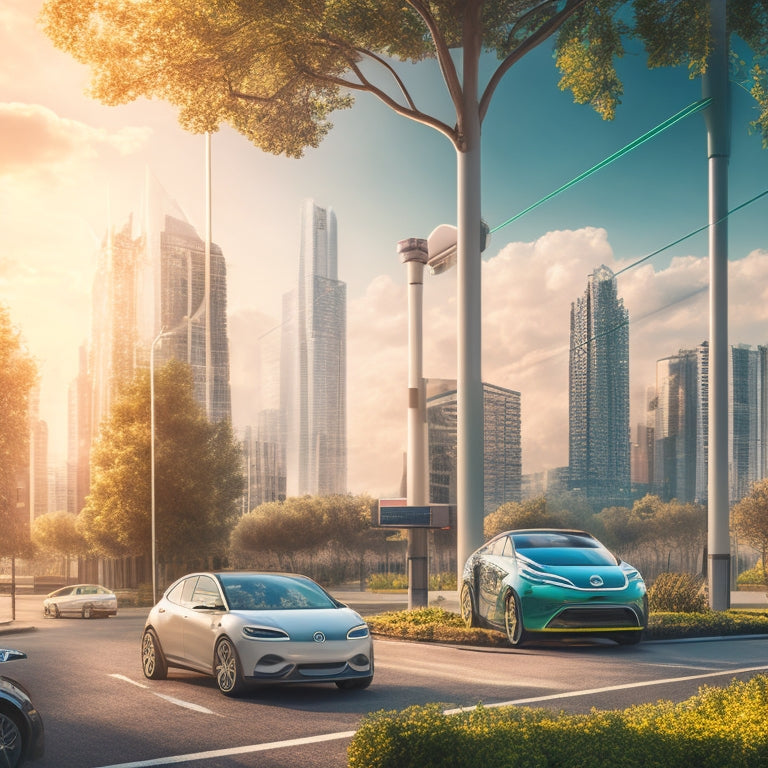
Designing Efficient Vehicle Charging Infrastructure Systems
Share
As you design efficient vehicle charging infrastructure systems, prioritize strategic planning and optimization to avoid costly inefficiencies and support widespread electric vehicle (EV) adoption. Optimize charging station placement, considering land use, urban density, and high-traffic areas. Implement high-power charging for fleets, incorporating rapid charge technology and scalable power distribution. Manage energy distribution networks, ensuring grid resilience and incorporating renewable energy sources. By integrating these solutions, you'll create efficient, scalable, and sustainable charging infrastructure systems. Now, explore these concepts in-depth to reveal the full potential of EV adoption.
Key Takeaways
• Optimize charging station placement considering land use, urban density, and high foot traffic areas to promote EV adoption and efficiency.
• Implement high-power charging technology to rapidly recharge vehicles, increasing fleet efficiency and scalability.
• Design high-capacity stations with meticulous planning for efficient land utilization, minimizing station footprint while maximizing charging capacity.
• Manage energy distribution networks using advanced forecasting, smart grid technologies, and load balancing to prevent infrastructure strain.
• Integrate renewable energy sources, energy storage, and vehicle-to-grid technology to reduce emissions, costs, and reliance on fossil fuels.
Optimizing Charging Station Placement
To maximize the effectiveness of electric vehicle (EV) adoption, you need to strategically locate charging stations. Haphazard placement can lead to inefficient use of resources, increased costs, and frustrated users. When planning EV charging infrastructure, it's crucial to take into account land use and urban density to guarantee ideal placement.
You should prioritize areas with high foot traffic, such as shopping centers, public transportation hubs, and urban hotspots, to increase visibility and accessibility. By doing so, you'll promote EV adoption and create a seamless user experience.
In densely populated urban areas, you should focus on installing charging stations near high-rise buildings, commercial centers, and public parking garages. This approach will help reduce range anxiety and cater to the needs of urban residents who may not have access to private parking or charging facilities.
High-Power Charging for Fleets
When designing high-power charging systems for fleets, you'll need to take into account the role of rapid charge technology in minimizing downtime.
You'll also need to think about the importance of high-capacity station design to support simultaneous charging of multiple vehicles.
Rapid Charge Technology
Rapid charge technology, capable of delivering up to 1 megawatt of power, is being developed to support the high-power charging needs of electric fleets. As you design your vehicle charging infrastructure system, it's essential to consider the rapid charging technology that will power your fleet.
Rapid charging technology offers several benefits for electric fleets, including:
-
Faster Charging Speed: With rapid charging, you can recharge your vehicles up to 80% in under 30 minutes, making it ideal for fleets that require quick turnaround times.
-
Increased Efficiency: Rapid charging technology reduces the time spent charging, allowing your fleet to operate at maximum efficiency.
-
Scalability: As your fleet grows, rapid charging technology can scale to meet your increasing power demands, ensuring your vehicles are always ready to go.
High-Capacity Station Design
You'll need to design high-capacity stations that can deliver up to 1 megawatt of power to support the high-power charging needs of your electric fleets. This necessitates meticulous planning to guarantee efficient land utilization, minimizing the station's footprint while maximizing its charging capacity. A well-designed station will have a significant impact on the overall efficiency of your fleet's operations.
When designing your high-capacity station, cable management is vital. You'll need to strategically plan the routing of high-power cables to minimize electrical losses and reduce the risk of overheating. This will require careful calculation of cable sizes, routing, and connections to ensure safe and efficient power distribution.
A well-managed cable system won't only improve the station's overall performance but also reduce maintenance costs and downtime. By prioritizing land utilization and cable management, you can create a high-capacity charging station that meets the unique needs of your electric fleet, guaranteeing fast, reliable, and efficient charging operations.
Scalable Power Distribution
To guarantee seamless high-power charging for your electric fleets, designing a scalable power distribution system is essential, as it enables the efficient allocation of electrical power to multiple charging points. This is particularly important when it comes to high-power charging for fleets, where multiple vehicles need to be charged simultaneously.
A well-designed power distribution system ensures that electrical power is distributed efficiently, preventing overload and ensuring grid resilience. To achieve this, you should consider the following key aspects:
-
Load Balancing: Implementing load balancing techniques ensures that the electrical load is distributed evenly across multiple charging points, preventing overload and reducing the risk of grid instability.
-
Grid Resilience: A scalable power distribution system should be designed to withstand grid fluctuations and ensure continuous charging operations even during periods of high demand.
-
Redundancy and Backup Systems: Incorporating redundant systems and backup power sources ensures that charging operations can continue uninterrupted, even in the event of a primary power failure.
Managing Energy Distribution Networks
As electric vehicles increasingly rely on the grid for power, managing energy distribution networks becomes vital to prevent brownouts, blackouts, and strained infrastructure. You need to guarantee that your energy distribution network can handle the increased demand from EV charging. This requires advanced energy forecasting techniques to predict energy usage patterns and adjust your network accordingly.
By doing so, you'll be able to identify potential bottlenecks and take proactive measures to prevent them.
Network resilience is essential in this situation. You should design your energy distribution network to be flexible and adaptable, with built-in redundancies and backup systems to minimize the impact of outages or failures.
This might involve implementing smart grid technologies, such as advanced sensors and automation systems, to monitor and control energy flow in real-time. By prioritizing network resilience, you can ensure that your energy distribution network remains reliable and efficient, even in the face of increased EV charging demand.
Efficient Charging Station Design
When designing an efficient charging station, you'll need to take into account the best layout to minimize congestion and reduce wait times. This involves strategically positioning charging points, walkways, and amenities to guarantee a seamless user experience.
Station Layout Optimization
By strategically arranging charging stations, electrical distribution systems, and other essential components, you can greatly reduce the footprint and construction costs of your electric vehicle charging infrastructure. A well-designed station layout can also improve the overall user experience, making it more convenient and accessible for drivers.
To optimize your station layout, consider the following key factors:
-
Accessibility analysis: Confirm that charging stations are easily accessible for drivers with disabilities, and that pedestrian paths and parking spaces are clear of obstacles.
-
Wayfinding strategies: Implement clear signage and visual cues to guide drivers to available charging stations, reducing congestion and confusion.
-
Efficient traffic flow: Design the station layout to minimize traffic congestion, allowing drivers to easily enter and exit the charging area.
Power Distribution Strategies
You can guarantee efficient charging station design by optimizing power distribution strategies, which involves configuring electrical infrastructure to support multiple charging points while minimizing energy losses and reducing installation costs. A well-designed power distribution system ensures that electrical power is efficiently distributed to each charging point, reducing the risk of overloading and downtime.
To achieve this, you can implement load balancing techniques that distribute the electrical load evenly across multiple charging points. This not only reduces energy losses but also increases the overall efficiency of the charging station. Additionally, energy routing strategies can be employed to optimize the flow of electrical energy, reducing energy losses and increasing the reliability of the charging station.
| Strategy | Benefits |
|---|---|
| Load Balancing | Reduces energy losses, increases efficiency |
| Energy Routing | Optimizes energy flow, increases reliability |
| Hybrid Approach | Combines load balancing and energy routing for maximum efficiency |
Integrating Renewable Energy Sources
As the transportation sector increasingly relies on electricity, integrating renewable energy sources into vehicle charging infrastructure systems becomes essential to minimize reliance on fossil fuels and mitigate climate change.
You'll want to prioritize the use of renewable energy sources to power your charging stations. This not only reduces greenhouse gas emissions but also decreases operating costs.
When designing your charging infrastructure, consider the following renewable energy integration strategies:
-
Solar Farms: Integrate solar farms to generate electricity and feed it directly into your charging infrastructure. This approach reduces reliance on the grid and minimizes carbon emissions.
-
Energy Storage: Implement energy storage systems to store excess energy generated by renewable sources, ensuring a stable and reliable power supply.
-
Grid Services: Utilize advanced grid services to optimize energy distribution, predicting and managing energy demand to guarantee a seamless charging experience.
Vehicle-to-Grid Technology Benefits
As you design efficient vehicle charging infrastructure systems, you'll want to explore the benefits of vehicle-to-grid (V2G) technology.
Vehicle-to-grid (V2G) technology enables electric vehicles to act as energy storage devices, feeding electricity back into the grid when not in use, and providing a range of benefits, including peak demand management and grid stability.
By harnessing the energy stored in your electric vehicle, you can contribute to grid resiliency and stability, reducing the strain on the grid during peak hours. This, in turn, enables utilities to better manage energy distribution and reduce the likelihood of power outages.
Additionally, V2G technology allows you to take advantage of energy arbitrage, selling excess energy back to the grid when prices are high and buying it back when prices are low. This not only benefits the grid but also puts money back in your pocket.
Urban Planning for EV Adoption
As you design efficient vehicle charging infrastructure systems, it's vital to contemplate urban planning strategies that support EV adoption. Effective urban planning for EV adoption involves strategically siting charging infrastructure in high-demand areas, such as shopping centers, office parks, and public parking garages, to maximize convenience and accessibility for drivers.
To achieve this, you'll need to:
-
Optimize land use: Identify areas with high foot traffic and limited parking availability, making them ideal for charging infrastructure installation.
-
Update zoning regulations: Revise zoning laws to accommodate EV charging infrastructure, ensuring that new developments incorporate charging stations.
-
Enhance urban mobility: Design charging infrastructure that integrates with public transportation systems, promoting a seamless shift between electric vehicles and mass transit.
Scalable Charging Infrastructure Solutions
You'll need scalable charging infrastructure solutions that can adapt to growing EV adoption rates, supporting high-power charging corridors along highways and urban hubs. As the demand for electric vehicles (EVs) increases, your charging infrastructure must be able to keep up. This means designing systems that can handle high volumes of simultaneous charging, while also ensuring efficient energy distribution.
To achieve this, consider integrating Smart Grid technologies that can manage energy supply and demand in real-time. This will enable you to optimize energy distribution, reduce strain on the grid, and minimize the risk of power outages.
| Scalable Charging Solutions | Key Benefits |
| High-Power Charging Corridors | Reduced charging times, increased EV adoption |
| Energy Storage Systems | Load management, peak shaving, and grid stability |
| Smart Grid Integration | Real-time energy management, optimized energy distribution |
| Modular Charging Infrastructure | Easy upgrades, reduced maintenance, and increased flexibility |
Frequently Asked Questions
Can Vehicle Charging Infrastructure Be Integrated With Existing Gas Stations?
You can repurpose existing gas stations into hybrid fueling hubs, integrating EV charging infrastructure through station retrofits, allowing you to offer both gasoline and electric fueling options, minimizing disruptions to your operations.
How Do Weather Conditions Affect Electric Vehicle Charging Efficiency?
'Can you imagine charging your EV on a freezing winter morning, only to find it takes longer than expected? That's because temperature fluctuations greatly impact charging efficiency, with extreme climates exacerbating the issue, making climate impact a critical consideration.'
What Are the Benefits of Using DC Fast Charging Over Level 2?
When you opt for DC fast charging over Level 2, you'll experience notably faster charging speeds, reducing wait times, and minimizing energy loss, making it an ideal choice for your electric vehicle's needs.
Can Electric Vehicle Charging Infrastructure Be Designed for Multi-Unit Dwellings?
Did you know that 80% of EV owners charge at home? You can design charging infrastructure for multi-unit dwellings by implementing shared parking and metered charging, ensuring efficient energy distribution and minimizing costs.
Are There Specific Charging Station Designs for Rural or Remote Areas?
When you venture into rural or remote areas, you'll find charging station designs tailored to these regions, often incorporating off-grid solutions to guarantee Rural connectivity, and you'll appreciate the carefully planned infrastructure that supports electric vehicle adoption.
Related Posts
-

7 Best RV Battery Charging Panels for Your Adventures
You're searching for reliable and efficient solar charging solutions to power your RV battery on the go. Explore top-...
-

5 Best Practices for Long-Lasting Sustainable Batteries
To maximize the lifespan of your batteries, you should optimize charging cycles by maintaining a charge level between...
-

What Are the Best RV Battery Charging Systems?
You need a reliable RV battery charging system that meets your power requirements, guarantees efficient energy storag...


